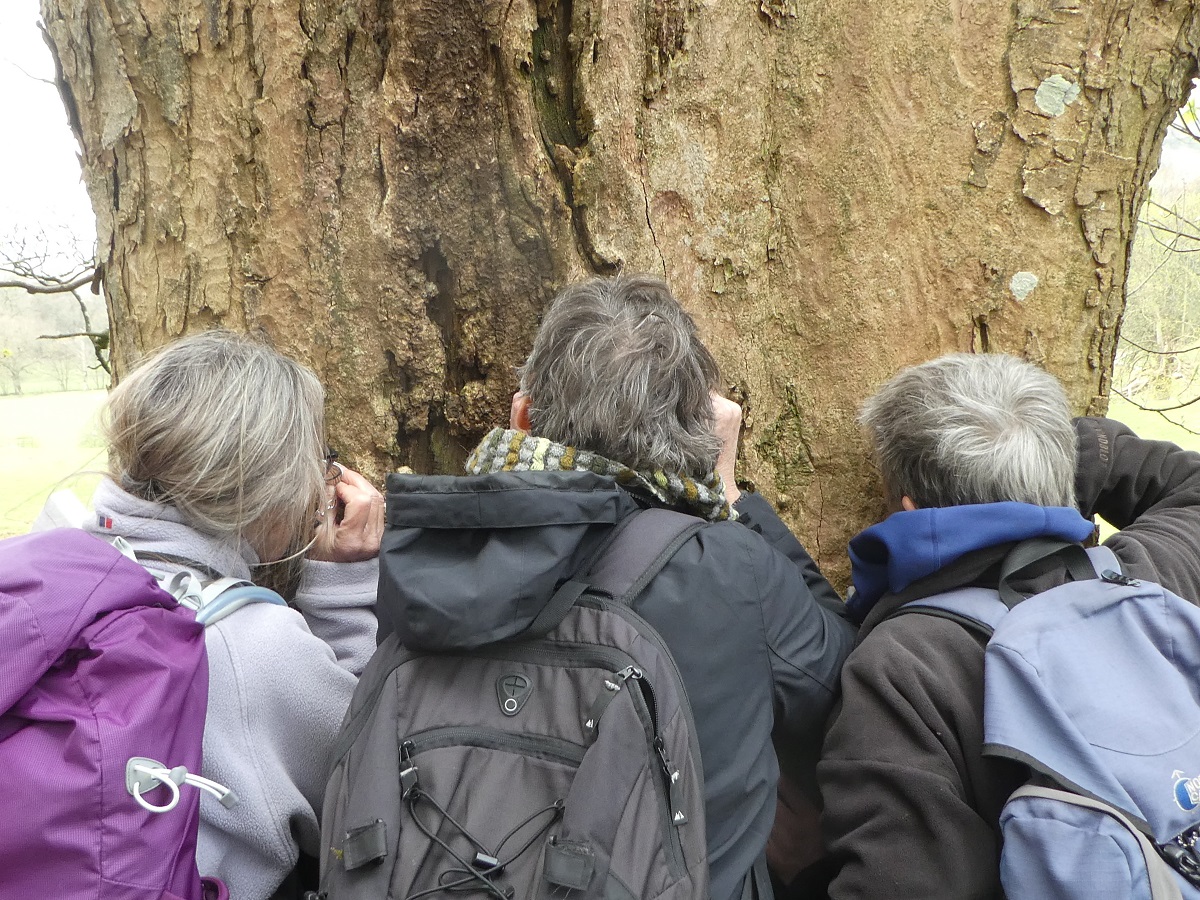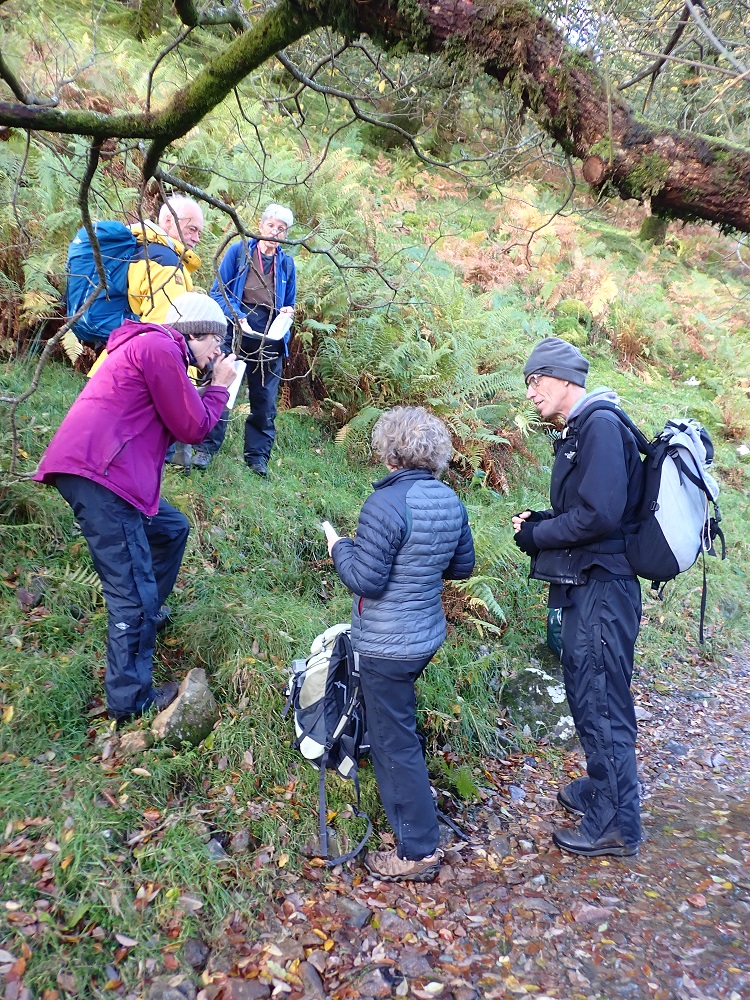Identifying lichens can be hard, but once you get started it can become compulsive.
There’s a list here of lichens rated by difficulty of identification going from (1) easy to (5) very hard. Some species are clearly identifiable (even from a moving vehicle). For others, use of a microscope, thin-layer chromatography or even DNA analysis is necessary. Sometimes, as a beginner, it can be enough to identify something to genus: working out which species it is can come along later.
But remember: absolutely everyone has started their “identification career” by knowing nothing about lichens!
In the field
Use a hand lens and make notes, take good close up and context photos. Putting in something (like a ruler) for scale can be useful.
There’s something on identification from photos here.
The following crib sheet (download as Word or PDF) can provide a list of useful characteristics to note:
| Category | Examples | |
| Overall appearance (“jizz”) | large and leafy covering trunk | |
| Habitat | What is it growing on- tree or earth or rock? | Where in the country? Tree type if known Rock type if known |
| Detailed habitat (micro-habitat) | Where on the tree/earth/rock? Damp, shade, vertical, horizontal? Which aspect/way is it facing? | |
| Thallus type | Foliose, fruticose, crustose, leprose, squamulose | NB there are others e.g. Cladonia |
| Thallus size | Dimensions of whole thallus Dimensions of lobe Is there “lots of it”? | |
| Thallus colour | Wet and dry | |
| Upper and underside | ||
| Thallus edge | Shape Prothallus (crustose) Thickness (crustose) | |
| Thallus features | Are there areoles? Are there squamules? | |
| Rhizines | Appearance | Where are they on thallus |
| Cilia | Appearance | Where are they on thallus |
| Soredia | Appearance | Where are they on thallus |
| Isidia | Appearance | Where are they on thallus |
| Pseudocyphellae & cyphellae | Appearance | Where are they on thallus |
| Apothecia | Lecanorine (jam tarts) Lecideine (wine gums) Arthonioid Lirellate Or are they perithecia? | There are other shapes |
| Any other surface features? | Shiny? Tomentose (hairy)? Bullate? Cracked? Pruinose? | |
| Reaction with K | ||
| Reaction with C | ||
| Other |
Whilst this might all be a bit overwhelming at the beginning, another way of looking at it is that it shows there are lots of different clues that can help with identification.
Afterwards
Follow up by reading Dobson/LGBI and looking things up online. Useful websites can include:
- BLS Species Descriptions
- British Lichens: picture index
- Dorset Nature
- There are many more websites from across the world with great pictures. Some suggestions are given in the resources section of the Learn the Language course.
- Check the maps to see the distribution of your species
- Keep samples - your own herbarium can be very useful: https://britishlichensociety.org.uk/resources/herbaria
Some useful tips
- Check that your chemicals are working OK using previously identified material known to give results e.g. K on Xanthoria parietina or C on the medulla of a Melanelixia species.
- Appreciate that lichens show variability- in shape, colour and chemistry. Even if the chemicals are ok, lichens vary in their reaction to them.
- Terms can be difficult to interpret. The “Learning the Language” course and the glossaries on the BLS website are great, but everyone gets confused by terms at times. There is often no standardisation of the way different people use a term: when does a lobule become a lobe? Or vice versa?
- Sometimes the books don’t say anything about chemical reactions for a species, and sometimes they won’t agree about chemical tests etc. You may be the first person to wonder about something. Make notes.
- Lichens can occur on a range of substrates, so a species reported to be “mainly corticolous” can also occur on stone or something else entirely.
- It can be really useful to make your own list of “look-alikes”: the books mention some but not all.
- Accept that many specimens will not be identifiable for a number of reasons.
- Don’t get overwhelmed. Start off with just a few things and add other species to “what you know” gradually. Many of us have a number of species that we know, but just haven’t put a name to yet!
- Foliose and fruticose lichens are probably the easiest to start with. And whilst they are fascinating, it may be an idea to avoid Cladonia species until you are more experienced.
- It can really help to get to know what is local to your area. Get familiar with your local patch. Whilst there is a temptation to visit hotspots, there can be so many species there that it becomes overwhelming. On the other hand such places can be inspirational.
- Zoom groups can support lichenologists at beginner and intermediate levels: contact zoom-improvement@britishlichensociety.org.uk.
- Join a local group or start going out with other people. It is much easier (and usually more fun) to learn with others. Don’t be afraid of asking more experienced people if you can go out with them. Local lichen group events can be found here.
- Look at/contribute to online groups (e.g. Facebook) or Twitter.

